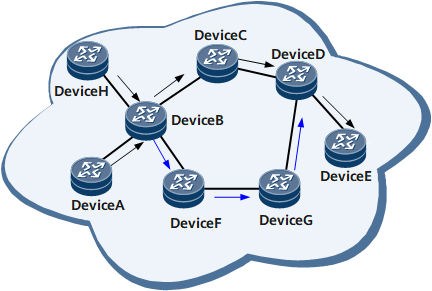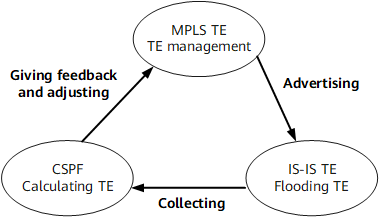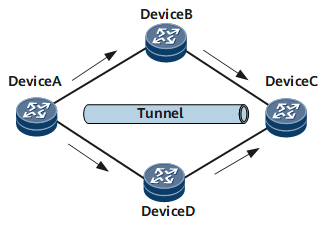IS-IS TE
IS-IS TE supports MPLS establishment and maintenance of Constraint-based Routed Label Switched Paths (CR-LSPs).
To establish CR-LSPs, MPLS needs to learn the traffic attributes of all the links in the local area. MPLS can acquire the TE information of the links through IS-IS.
Traditional routers select the shortest path as the primary route regardless of other factors, such as bandwidth, even when the path is congested.
On the network shown in Figure 1, all the links have the same cost (10). The shortest path from DeviceA/DeviceH to DeviceE is DeviceA/DeviceH → DeviceB → DeviceC → DeviceD → DeviceE. Data is forwarded along this shortest path. Therefore, the path DeviceA (DeviceH) → DeviceB → DeviceC → DeviceD → DeviceE may be congested whereas the path DeviceA/DeviceH → DeviceB → DeviceF → DeviceG → DeviceD → DeviceE is idle.
To resolve the preceding problem, the cost of the path from DeviceB to DeviceC can be set to 30 so that the traffic is switched to the path DeviceA/DeviceH → DeviceB → DeviceF → DeviceG → DeviceD → DeviceE.
This method eliminates the congestion on the link DeviceA/DeviceH → DeviceB → DeviceC → DeviceD → DeviceE; however, the other link DeviceA (DeviceH) → DeviceB → DeviceF → DeviceG → DeviceD → DeviceE may be congested. In addition, on networks with complicated topologies, changing the cost of one link may affect multiple routes.
As an overlay model, MPLS can set up a virtual topology over the physical network topology and map traffic to the virtual topology, effectively combining MPLS and TE technology into MPLS TE.
MPLS TE can resolve network congestion problems by allowing carriers can precisely control the path through which traffic passes and prevent traffic from passing through congested nodes. Meanwhile, MPLS TE can reserve resources during the establishment of LSPs to ensure service quality.
To ensure continuity of services, MPLS TE provides the CR-LSP backup and fast reroute (FRR) mechanisms. If a link fault occurs, traffic can be switched immediately. Through MPLS TE, service providers (SPs) can fully utilize the current network resources to provide diverse services, optimize network resources, and methodically manage the network.
To accomplish the preceding tasks, MPLS TE needs to learn TE information about all devices on the network. However, MPLS TE lacks a mechanism in which each device floods its TE information throughout the entire network for TE information synchronization. However, IS-IS does provide such a mechanism. Therefore, MPLS TE can advertise and synchronize TE information with the help of IS-IS. To support MPLS TE, IS-IS needs to be extended.

Basic Principles
IS-IS TE is an extension of IS-IS intended to support MPLS TE. As defined in standard protocols, IS-IS TE defines new TLVs in IS-IS LSPs to carry TE information to help MPLS implement the flooding, synchronization, and resolution of TE information. Then, IS-IS TE transmits the resolved TE information to the CSPF module. In MPLS TE, IS-IS TE plays the role of a porter. Figure 2 illustrates the relationships between IS-IS TE, MPLS TE, and CSPF.
To carry TE information in LSPs, IS-IS TE defines the following TLVs in standard protocols:
Extended IS reachability TLV
The Extended IS reachability TLV replaces the IS reachability TLV and extends the TLV format using sub-TLVs. The implementation of sub-TLVs in TLVs is the same as that of TLVs in LSPs. Sub-TLVs are used to carry TE information configured on physical interfaces.

All sub-TLVs defined in standard protocols are supported.
Table 1 Sub-TLVs defined in the extended IS reachability TLV Name
Type
Length (Byte)
Administrative Group
3
4
IPv4 Interface Address
6
4
IPv4 Neighbor Address
8
4
Maximum Link Bandwidth
9
4
Maximum Reserved Link Bandwidth
10
4
Unreserved Bandwidth
11
32
Traffic Engineering Default Metric
18
3
Bandwidth Constraints sub-TLV
22
36
Traffic Engineering router ID TLV
The type of this TLV is 134, and this TLV carries a 4-byte router ID (MPLS LSR-ID). In MPLS TE, each device has a unique router ID.
Extended IP reachability TLV
The Extended IP reachability TLV replaces the IP reachability TLV and carries routing information. It extends the length of the route cost field to 4 bytes and carries sub-TLVs.
IS-IS TE consists of two procedures:
Responding to MPLS TE configurations
IS-IS TE functions only after MPLS TE is enabled.
IS-IS TE updates the TE information in IS-IS LSPs based on MPLS TE configurations.
IS-IS TE transmits MPLS TE configurations to the CSPF module.
Processing TE information in LSPs
IS-IS TE extracts TE information from IS-IS LSPs and transmits the TE information to the CSPF module.
Usage Scenario
IS-IS TE helps MPLS TE set up TE tunnels. In Figure 3, a TE tunnel is set up between Device A and Device C.
The configuration requirements are as follows:
MPLS TE and MPLS TE CSPF are enabled on Device A.
MPLS TE is enabled on Device B, Device C, and Device D.
IS-IS and IS-IS TE are enabled on Device A, Device B, Device C, and Device D.
After the configurations are complete, IS-IS on Device A, Device B, Device C, and Device D sends LSPs carrying TE information configured on each Device. Device A then obtains the TE information of Device B, Device C, and Device D from the received LSPs. The CSPF module can calculate the path required by the TE tunnel based on the TE information collected across the entire network.


